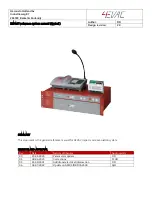
1. OPERATION
21
Auto shift:
Turn the auto shift feature on or
off. Select
Off
to shift the display manually
(with
S
or
T
).
On
automatically tracks the
bottom echo to keep it on the bottom half of
the display. For example, the distance to the
bottom is 350 ft and the range is set to 0-60 ft.
Then, auto shift automatically places the bot-
tom echo on the display, without changing the
range. "AUTO S" appears at the upper left
corner when auto shift is active.
S
and
T
are
inoperative when auto shift is active.
Note 1:
Auto shift is inoperative when auto
range is active.
Note 2:
The bottom echo must be displayed
in reddish brown or red in order for auto shift
to function.
Freq. Choice:
You can register up to four dif-
ferent frequencies for a single transducer, fol-
lowing the procedure in "Freq. Control" in the
Sounder menu. Then, you select here the
high and low frequencies to use. Note that
Accu Fish must be turned off to use this fea-
ture.
1. Select Freq. Choice and press the
EN-
TER
key. The choices available depend
on the transducers you have. The choices
below are for 200 kHz (high frequency)
and 50 kHz (low frequency).
2. Use
S
or
T
to select HF Terminal or LF
Terminal as appropriate and press the
ENTER
key. The frequencies preset with
Freq Control are shown.
3. Use
S
or
T
to select applicable frequen-
cy and press the
ENTER
key. The picture
for the frequency selected here is shown
on the display.
Freq Control:
Four different transducer fre-
quencies and frequency adjustment range
are automatically set at installation. However,
the range of frequency adjustment for each
frequency may be different depending on in-
stallation characteristics. For example, for a
200 kHz frequency transducer, the default fre-
quencies are 200 kHz, 196 kHz, 198 kHz and
204 kHz. If those frequencies are not suitable
for your use, you can change them. Further, in
case of a wide-bandwidth transducer, fre-
quencies may be chosen from the available
frequency range. This allows you to have mul-
tiple frequencies for a single transducer. For
example, if you have the transducer 82B-35R,
you can register frequencies between 66 kHz
and 109 kHz. The frequencies registered here
may be selected at Freq Choice in the Sound-
er menu.
Set transducer frequency keeping in mind
these considerations.
• Set frequency which is suitable for detect-
ing targeted fish.
• Shift frequency so as to reduce interfer-
ence.
• Lower frequency to increase detection
range.
• Raise frequency to improve resolution.
Transducer connected
to HF terminal
Transducer connected
to LF terminal
(1) 200 kHz trans. connected to HF terminal;
50 kHz trans. connected to LF terminal
Frequency shown
on HF display
Frequency shown
on LF display
Freq Choice
HF Freq
: 200.0kHz(HF Terminal)
LF Freq
: 50.0kHz(LF Terminal)
Freq Choice
HF Freq
: 200.0kHz(HF Terminal)
LF Freq
: 198.0kHz(HF Terminal)
(2) 200 kHz trans. connected to HF
terminal; no trans. connected to LF terminal
(3) 50 kHz trans. connected to LF terminal;
no trans. connected to HF terminal
Freq Choice
HF Freq
: 50.0kHz(LF Terminal)
LF Freq
: 49.4kHz(LF Terminal)
(1) Configuration
(2) Configuration
(3) Configuration
200.0kHz(HF Terminal)
196.0kHz(HF Terminal)
50.0kHz(LF Terminal)
51.0kHz(LF Terminal)
200.0kHz(HF Terminal)
196.0kHz(HF Terminal)
198.0kHz(LF Terminal)
204.0kHz(LF Terminal)
50.0kHz(HF Terminal)
49.0kHz(HF Terminal)
49.4kHz(LF Terminal)
51.0kHz(LF Terminal)
















































